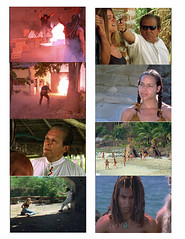Along the northern Mexican border, fear rules ... as the death toll grows in a drug smuggling war.
"Competing Mexican drug cartels are destroying each other ... and that's where 'Warrior' begins ...."
http://imdb.com/title/tt0320751
http://www.warriorthefilm.blogspot.com
"the action adventure fantasy feature film "Warrior" ... about the son of a divine force ... is a story of a young man's quest to find his true identity set against the twin backdrops of Native American folklore and the treacherous Mexican drug trade and a portrayal of the classic confrontation between "good and evil" ... filmed in the exotic jungles of Costa Azul and the urban grit of Puerto Vallarta in the State of Jalisco, Mexico .. with action, adventure, romance, comedy, a multi-ethnic cast, a major studio movie music score and spectacular cinematography..."
http://www.latimes.com/news/nationworld/world/la-fg-laredo23nov23,1,3185104.story?coll=la-headlines-world
Along the northern Mexican border, fear rules
Police jobs go unfilled and a terrorized public demands reform as the death toll grows in a drug smuggling war.
By Sam Enriquez and Richard Marosi
Times Staff Writers
November 23, 2006
NUEVO LAREDO, MEXICO — The top cop in this unhinged border city has 300 openings on a 600-member police force, and his fearful greeting gave a big clue why.
"Please, please don't use my name or take a photograph," the interim chief begged.
One police chief was killed last year, a second quit in the spring, and no one else appears brave enough, or foolhardy enough, to work this side of the law in Nuevo Laredo.
Mexican President Vicente Fox quietly withdrew the federal police he dispatched with great fanfare last year to bring peace, leaving the city virtually unprotected in a smuggling war that has claimed 170 lives since January.
This isn't the only border city where law and order are on the ropes.
In Tijuana, the rate of kidnappings ranks among the world's worst and some state police have refused postings after the killings of more than a dozen officers, some at restaurants and on city streets.
Organized crime is out of control, Tijuana Mayor Jorge Hank Rhon said after a police commander was ambushed this month. The killing of police officers, he said, "speaks to the impunity of organized crime, that they think they're above the law, or protected."
As Mexico prepares for a peaceful transfer of power Dec. 1 with the inauguration of Felipe Calderon, the president-elect must take stock of the country's 2,000 drug-related slayings this year, residents and officials say.
"Calderon needs to apply the law or reform the law," said Nuevo Laredo resident Ana de la Cruz, the mother of two teenage daughters. "We urgently need help."
The drug problem that spans the United States and Mexico neither starts nor ends in these two border cities. But a healthy chunk of U.S.-bound dope lumbers past each day.
"The number of addicts is growing," said Adan Rosa Ramos, 24, a recovering methamphetamine user who works at a rehabilitation house in Nuevo Laredo. "There's a lot more drugs on the street."
The proximity of these cities to the United States is a blessing and a curse. The Tijuana-San Diego frontier is the busiest border crossing in the world. At Nuevo Laredo, trucks and trains ferry more than 40% of the goods traded between the neighboring countries.
The two cities also account for the most lucrative smuggling routes in the hemisphere. The tons of cocaine, marijuana, heroin and methamphetamine seized by authorities each year is a fraction of what moves past them in trucks, cars, planes and tunnels.
Here's the arithmetic, said Daniel Covarrubias, the director of economic development in Nuevo Laredo: "The U.S. checks maybe 10% of the trucks that pass. Any more than that and it slows commerce. You run 10 trucks and take your chances."
Battle for control of the Nuevo Laredo corridor pits the Pacific Coast Sinaloa cartel against the Gulf cartel, whose top gunmen defected from an elite Mexican army task force. The conflict has spread to the states of Michoacan and Guerrero, where nearly 600 people were believed killed in drug-related homicides this year.
In Tijuana, the August arrest of alleged drug cartel leader Francisco Javier Arellano Felix escalated a battle among rivals believed responsible this year for many of the 318 killings in that city.
With government all but ceding control of the border, civil society has fallen into disarray or been cowed into silence. Newspapers in Nuevo Laredo have stopped reporting drug killings under pressure from advertisers, government and drug dealers.
Residents learned a lesson from Police Chief Alejandro Dominguez, who was gunned down in June 2005 within hours of taking office. He'd pledged to stand up to drug traffickers, who presumably responded in kind.
Dominguez's replacement quit and the interim chief closed his office door during a recent interview and said he wouldn't speak a word about the drug business and didn't want to be identified.
His name isn't important, and apparently neither is his job. Most of the force of almost 800 police officers was fired last year for corruption. About 300 recruits are working, but they spend their days mostly staying out of sight and out of trouble.
Even with out-of-town recruiting trips, there are no takers for 300 police jobs, including the chief's slot. Starting salaries of $600 a month apparently aren't worth it.
"Last year was bad," said the La Paz funeral home's assistant director, Alvaro Ordañez Sanchez. "A lot of cops."
Tallying the 170 people shot, burned and garroted so far in the drug war, Ordañez estimated the toll in Nuevo Laredo would approach 200 this year. That would make up about 10% of the drug-related homicides in Mexico, even though Nuevo Laredo, a city of 380,000, accounts for less than 0.4% of the nation's population.
Ordañez, whose firm also performs autopsies for the city, seems to be the only one willing to talk about the drug violence.
Elizabeth Hernandez, a state prosecutor responsible for deciding whether a homicide in Nuevo Laredo should be investigated by state or federal authorities, said she didn't know how many people had been killed.
"I've only been on the job nine months," said Hernandez, who suggested a visit to the federal prosecutor's office.
Assistant federal prosecutor Jose Enrique Corona rolled his eyes an hour later. "Of course she knows," he said.
When asked whether his office was investigating the slaying of Dominguez, the 56-year-old father who served only six hours as chief, Corona said the case was being handled by federal investigators in Mexico City. Prosecutors in Mexico City said it wasn't theirs. The truth is, few killings are investigated and almost none are solved.
"This is a city of lies," said one of the local reporters whose daily newspaper no longer covers drug killings. He was afraid to be named. "Last year we reported on all the killings, and business and government officials blamed us for disrupting commerce. Now police say nothing happens here. What a paradise."
Residents take pains to dodge the menace of drug trafficking. Some deny it exists. Look at the peaceful plazas, say boosters, and the thousands of trucks that ferry commercial goods daily to and from the United States.
"If you behave on the streets, you won't get into trouble," Tamaulipas Gov. Eugenio Hernandez Flores told potential investors during a business forum in Nuevo Laredo, which is linked by bridges with Laredo, Texas. An unofficial tally by the newspaper Milenio found 145 police officers were slain this year, a dozen of whom were from Tamaulipas.
When the Tijuana mayor favorably compared his city's crime rate with that of San Diego, some residents were stunned.
"Apparently, he's living somewhere else," said Genaro de la Torre, leader of a citizens safety group that helped organize a recent anti-violence march. "He needs to suffer what the people have suffered to realize what is really going on."
President-elect Calderon has proposed better police training, consolidation of federal law enforcement units into a single agency and creation of a national crime database.
"During the last few years, and really the last months, violence and organized crime have grown in an alarming way," Calderon told a business group last week. "We can't accept that as the image of Mexico. We can't have a daily image of executions and other bloody acts that go unpunished."
The Lopez family, which used to run a money exchange house on Nuevo Laredo's central plaza, is still waiting for justice. Thugs kidnapped one brother last month and returned the next morning for a second brother.
"He grabbed onto the pole of a payphone and wouldn't let go, so they shot him in the leg," said a reporter who interviewed witnesses. "He still wouldn't let go, so they shot him in the arm and took him. People said they called police, but nobody came."
*
sam.enriquez@latimes.com
richard.marosi@latimes.com
Enriquez reported from Nuevo Laredo and Marosi from Tijuana. Carlos Martínez and Cecilia Sánchez of The Times' Mexico City Bureau contributed to this report.
Copyright 2006 Los Angeles Times | Privacy Policy | Terms of Service
Home Delivery | Advertise | Archives | Contact | Site Map | Help
"the action adventure fantasy feature film 'Warrior' ... about the son of a divine force ... is a story of a young man's quest to find his true identity set against the twin backdrops of Native American folklore and the treacherous Mexican drug trade and a portrayal of the classic confrontation between "good and evil" ... filmed in the exotic jungles of Costa Azul and the urban grit of Puerto Vallarta in the State of Jalisco, Mexico .. with action, adventure, romance, comedy, a multi-ethnic cast, a major studio movie music score and spectacular cinematography..."



